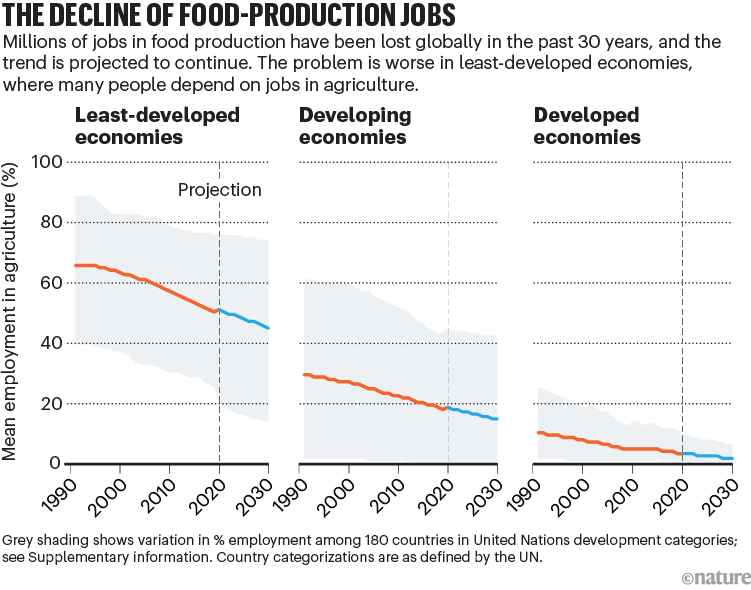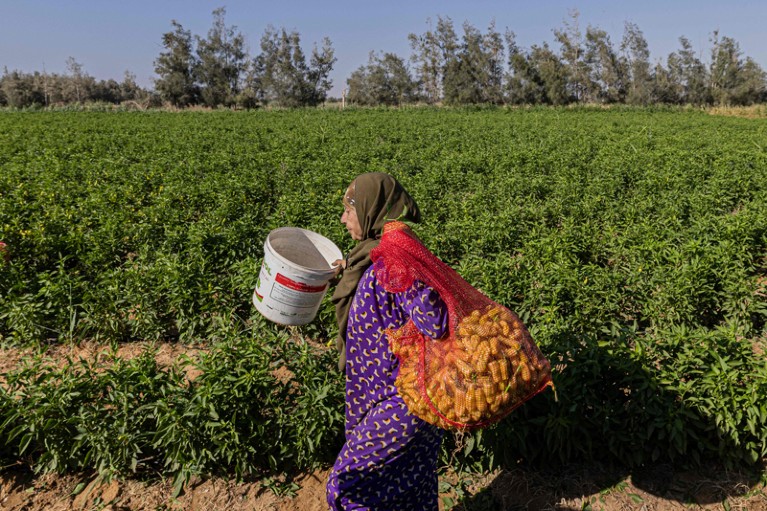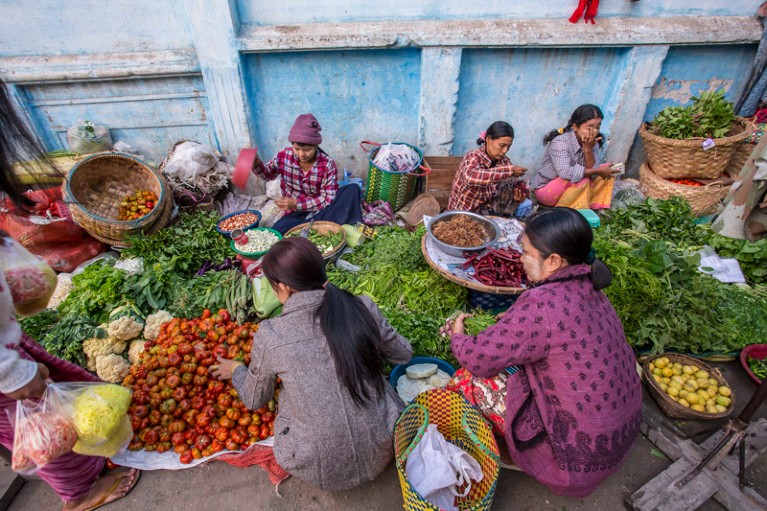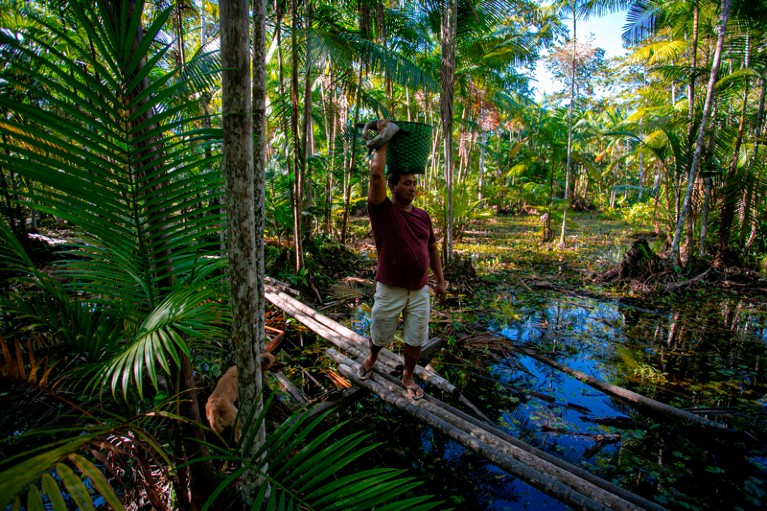Halting the loss of jobs and knowledge from small-scale producers requires investing in rural sustainability, addressing poverty and inequity and ensuring the economic gains stay local. The benefits would be shared globally
Eduardo S. Brondizio, Stacey A. Giroux, Julia C. D. Valliant, Jordan Blekking, Stephanie Dickinson & Beate Henschel in Nature | 31/07/2023
Making progress on internationally agreed goals for sustainable development, climate change and biodiversity will require major changes to how the world’s food is produced and distributed1. In 2021, the World Bank estimated that current food systems account for US$12 trillion in hidden social, economic and environmental costs2.
In recent decades, global initiatives have emerged to start making those changes. And opportunities are arising to address poverty, inequity and other social problems alongside the climate and biodiversity crises, in part thanks to increased interest in making food production less environmentally destructive and more sustainable. Technological advances could also improve work conditions and boost production and market access for small- and mid-scale food producers.
Yet making such initiatives work at scale means reversing a trend that many people see as an inevitable consequence of modernity and progress: the movement of millions of people from rural regions to cities or their edges.
Employment data from the International Labour Organization, a United Nations agency, show that over the past 30 years, around 200 million jobs in food production have been lost globally (see ‘The decline of food-production jobs’). According to our analysis, the current pace could quicken, resulting in at least 120 million more jobs being lost by 2030 — mostly in low- and middle-income countries (LMICs; see Supplementary information). This massive global decline in employment has contributed to the breakdown of families and communities throughout LMICs as millions of people move to urban areas3, a process that is being intensified by climate change4. Following migration in and between countries, many people who end up in urban or peri-urban settings are living more precariously than they were before — lacking employment as well as basic services such as housing5. And intergenerational knowledge is disappearing: about the biodiversity used by farmers, fishers, pastoralists, forest and wild-species managers; of the technologies for producing food; and about how to manage the environment6.

Halting this trend requires three major shifts. First, governments and non-governmental organizations need to invest in basic infrastructure and public services (schools, transportation, digital technologies and so on) in rural and Indigenous areas. They should also help to reframe widely held narratives that consider small- and mid-scale food producers to have limited value. Second, more of the international and national initiatives to make food production more resilient and biodiverse must address social problems alongside environmental ones. Third, the economic benefits of producing food must be brought closer to where those foods are grown.
To be effective, initiatives need to consider the inherent rights of diverse Indigenous and rural communities, respect and draw on Indigenous and local knowledge and technologies, and be led by these communities. They also need to recognize the role and aspirations of young people as active agents in promoting attractive employment opportunities in the food economy7,8. Perhaps most crucially, entrenched assumptions stemming from academic theories developed in the nineteenth and twentieth centuries and held worldwide must be challenged. These include the ideas that small-scale and Indigenous food production and resource-management systems are unimportant for feeding the world’s people, and that the loss of jobs in rural and Indigenous areas is an inevitable and necessary consequence of countries becoming modern and efficient.
Small but mighty
Although most scholars, policymakers and governments focus their attention almost entirely on operations that produce commodities for export, the contributions of Indigenous, smallholder and family-based food-production systems are considerable. More than 866 million people support families and communities by working in agriculture, fisheries, pastoralism, forest management and other small- to mid-scale food-production systems. That’s 26% of the workforce globally, and more than 80% of that in some countries, such as Burundi. Around 89% of these people live in rural areas and Indigenous territories, and nearly 500 million Indigenous people manage more than one-quarter of the global land surface.
Smallholder farms (those on less than 2 hectares) by themselves provide around 35% of the global food supply and a much larger share in Latin America, sub-Saharan Africa, and south and east Asia9. Meanwhile, small-scale fisheries generate up to 110 million jobs, according to some estimates (see go.nature.com/478xt9g). This is more than the combined total of those in industrial fisheries, oil and gas production, shipping and tourism10.

Despite their importance, millions of small- to mid-scale food producers around the world face immense challenges. Difficulties obtaining bank loans or accessing markets create significant financial hurdles, and they often lack technical assistance and access to basic machinery, technology and logistical infrastructure. Their knowledge, practices and techniques are often disregarded and stigmatized in policy and development programmes. Where people are trying to produce food alongside vast commodity farms, even access to basic resources such as clean water and air can be unreliable.
Small- to mid-scale food producers are among those most vulnerable to the effects of climate change11; furthermore, this group includes 65% of the world’s people living in extreme poverty. Smallholder farmers and Indigenous groups in particular are often pressured by commodity industries to sell their land, and might be exposed to violence in their efforts to protect their territories and resources from land and water grabbing, illegal logging, mining, fishing or hunting. They are vulnerable to food prices being dictated by powerful actors in highly consolidated supply chains. They also lack the protection of labour legislation and social entitlements, such as social-security benefits and health insurance.
In many regions, the work of rural and Indigenous producers and the ownership of the land or waters they use is not formally recognized. Even locally, the work of producing food is not respected or valued, especially for women and girls12. Such invisibility is reflected in many national statistics, although more-inclusive assessments are beginning to emerge. In Brazil, for example, agricultural censuses accounting for the contribution of family-based agricultural food production began in 2006.
Changing mindsets and narratives
Since the late nineteenth century, academic theories about social evolution and economic structural transformations have predicted the inexorable disappearance of the world’s smallholders, agricultural labourers and Indigenous peoples, and their eventual incorporation into urban societies. These ideas continue to inform policies and negative social attitudes towards rural and Indigenous areas. Yet the dominant narrative — that people leave rural areas to adopt modern city life, and that small-scale and Indigenous food production will inevitably die out as employees move to industry jobs — does not hold up to scrutiny.
Unsurprisingly, the challenges we describe discourage many from engaging in food production in rural areas, particularly young people. But in numerous places, most of the jobs being lost in food production are not being replaced by jobs in industry or services. Employment in industry has remained constant during the past three decades, and opportunities in services vary significantly by region, leaving hundreds of thousands of young people unemployed and depending on informal work, particularly in LMICs3,8,13.
Yet the views of small- to mid-scale food producers tell a different story.
Four of us (E.S.B., S.A.G, J.C.D.V. and J.B.) have worked with smallholder food producers in Brazil, the United States, Zambia, Kenya and Italy, and with rural communities and Indigenous organizations in Amazonia14 and internationally1. Our work — along with reviews by others — has convinced us that what drives people out of rural regions is not the lure of city life per se, but the lack of opportunity to improve their situation where they live. Many people either want to return to their rural and Indigenous homelands or don’t want to leave. Often, they have to move away, because they can’t get access to the technology, infrastructure, education and basic services that would allow them to produce food more creatively and profitably, to do so with less hard labour and to have a better quality of life.

In a 2019 study of nearly 600 people in rural South Africa aged 15 to 35, 64% of the responses collected were negative towards agriculture. People saw it as a means of survival or a stepping stone to something better. In spite of an unemployment rate of 60%, they were not attracted to the available low-skill and low-pay jobs in agriculture, perceiving a social stigma towards such work. Yet 36% saw agriculture as a potential path and thought that revitalized small-scale agriculture could help their community to flourish15.
A 2021 study of more than 100 rural riverine communities in western Amazonia is perhaps even more revealing. It showed that only 5% of people engaged in profitable and socially valued community-based fisheries and forest management (in sustainable-use reserves) wanted to move to the city. By contrast, in neighbouring communities that were not involved in co-management systems in such reserves, 58% expressed this wish16. Although fishers struggle with the pressures of illegal markets and unfair prices paid by intermediaries, community-based fisheries-management systems have rescued the largest regional fishery — made up of Arapaima species — from the brink of extinction. According to Brazil’s environment ministry, these management systems currently involve and support more than 5,500 individual fishers in riverine and Indigenous communities.
Power to the people
We are not proposing that small-scale food production by itself is a solution to the social and environmental ills of large-scale farming and fisheries. But many such problems and their interconnections could be addressed by empowering the people who are already producing a significant share of the world’s food to produce that food more sustainably, profitably and creatively.
Over the past two decades, communication campaigns have tried to shift narratives around food production by branding jobs in agriculture and fisheries as just, engaging and rewarding. Examples include France’s 2009 media campaign, ‘Farming: fashionable work’, and Rwanda’s 2023 ‘Buy from Youth’ campaign. But to stem or reverse the global migration of people from rural areas, such campaigns must be accompanied by governmental and non-governmental investments. These need to increase people’s access to credit, technology and markets, and improve basic services such as schools, health care, transportation and access to clean water. Perhaps most importantly, there needs to be a shift in mindsets, so that prioritizing the needs of food-producing communities — and acknowledging and valuing their contributions — is normalized in national and global planning for economic development.
Likewise, a growing number of financial mechanisms and commitments — from intergovernmental, governmental and private sources — are being directed towards changing farming, forestry and fisheries practices. Their aim is to make food production more climate friendly, resilient and biodiverse, and to promote new economic opportunities2. These mechanisms add to hundreds of existing schemes for conservation, restoration, climate adaptation and mitigation. But so far, little attention has been given to employment in biodiversity-rich and climate-resilient food systems, or to the importance of also addressing social problems in Indigenous and rural areas.

In principle, many existing subsidies in agriculture and fisheries — estimated to be worth $540 billion and $35 billion per year, respectively — could be reconfigured to encourage more sustainable food production, and to help revitalize rural and Indigenous communities17,18. Take Amazonia. Decades of subsidies for cattle ranching in Brazil to boost beef exports continue to drive environmental degradation, inequality and the exploitation of workers19. Subsidies could instead be directed towards boosting employment and supporting rural communities — with credit for farmers, fishers and forest managers being linked to transitions to sustainable food-production practices, say.
Lastly, the benefits of food production must be brought closer to the places where that food is produced. This can be achieved through fair-trade agreements ensuring that the food is bought at a fair price, by enabling producers to sell directly to consumers or by providing credit support so that locally owned small- and mid-scale industry can process food locally20 (see Supplementary information). All of these interventions help to bring more of the economic benefits of food production to communities, including municipal tax revenue and diverse employment opportunities in food manufacturing and retailing.
Many examples show the possible gains of this approach. For instance, during the 1950s, the Mixed Agricultural Cooperative of Tomé-Açu (CAMTA) helped Brazil to become one of the world’s largest exporters of black pepper (see www.camta.com.br). But after fungal disease decimated pepper monocultures in the 1970s and 1980s, the cooperative broadened its range of products by adopting and adapting biodiversity-rich agroforestry systems used by Amazonian Indigenous and riverine farmers, and by creating a processing industry locally.
CAMTA partnered with governmental and non-governmental organizations and private industry to develop products including fruit pulps and oils, which are sold to customers ranging from local schools to international corporate buyers. Today, CAMTA’s food-processing industry employs 172 people and produces 5,000 tonnes of tropical-fruit products each year, grown by around 2,000 small- and mid-scale farmers. CAMTA estimates that its agroindustry generates around 10,000 direct and indirect jobs.
Consumers worldwide increasingly want to know more about their food and the people who produce it — whether products are organic or fair trade, where they come from, whether they are linked to deforestation and the infringement of Indigenous rights, and whether they involve unfair labour practices. Enabling the certification of food products and food supply chains can help to increase and diversify employment by making producers more visible to consumers, and by encouraging local production, processing, manufacturing and retailing. Meanwhile, new technologies that reduce hard labour or provide digital communications are making it easier for small- to mid-scale producers to bring the benefits of their efforts closer to home17,18.
Stemming the tide of job losses in food production and supporting diverse and inclusive food systems is not only about economics. With 1.2 billion people due to reach working age this decade, mainly in LMICs, the lack of employment opportunities threatens internationally agreed social and environmental goals (see Supplementary information). This includes the internationally agreed UN Sustainable Development Goals (SDGs)and the Convention on Biological Diversity’s ‘30×30’ target to protect 30% of Earth’s lands and oceans by 2030.
Addressing the problem of job losses in food production would achieve multiple aims. But doing so requires enhancing the livelihoods of rural and Indigenous populations and recognizing their knowledge bases and diverse needs. It means limiting the corporate consolidation and homogenization of food systems, revitalizing regional economies and making progress on climate, biodiversity and the SDGs. Perhaps most importantly, it means ensuring that people have dignified work and hope for the future, and that this becomes a priority for all.
Nature 620, 33-36 (2023)
doi: https://doi.org/10.1038/d41586-023-02447-2
First published in Nature
https://www.nature.com/articles/d41586-023-02447-2



